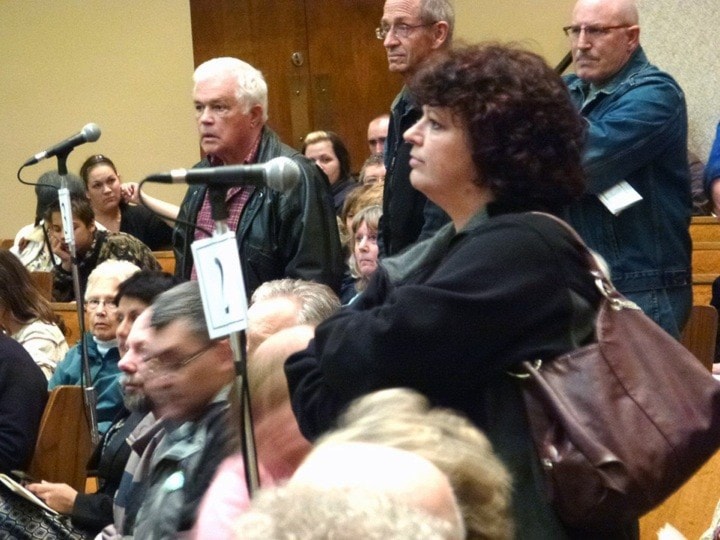They pleaded. They heckled. They tried to negotiate.
They yelled at, and even booed the official who hosted Fraser Health's information meeting Tuesday night on the prospect of continuous chlorination of Chilliwack's pristine water.
A crowd of more than 400 filled the Chilliwack Alliance Church to ask questions, and hear what Chief Medical Health officer Paul Van Buynder had to say.
Despite two and half hours of heated exchange, with all speakers saying that they don't want chlorination, there was no evident shift in the official position that chlorination is the best option for Chilliwack.
Van Buynder acknowledged the quality of Chilliwack's award-winning drinking water, and the efforts by staff to maintain the 450 kilometres of the water distribution system serving a growing population of more than 80,000.
"You have a really good water source, there's just no guarantee you can protect the system against incursions," he said.
Dr. Van Buynder's bottom line was that the risk to Chilliwack population of drinking untreated water superseded any risks of adding the secondary disinfectant, chlorine.
With a system the size and complexity of Chilliwack, there could be an estimated 70 to 100 breaks, or
"incursions" in the water system in a given year, caused by anything from illegal connections to a break in a pipe.
Chilliwack's three incidents of "minimal" E.coli detection, in 2009, 2011 and 2012, were isolated and confined to hillside reservoirs, which operate separately from the main water distribution system.
But even with water testing done twice as often as required, residents could still "be drinking it for four days," before something gets detected at the lab, if some form of bacteria should contaminate the water.
"You've got high-quality water in the groundwater source, and high quality city staff, but you can't have a foolproof system," without using a secondary disinfectant like chlorine, he said.
He's most worried about a nasty strain of E.coli, like the one that hit Walkerton, Ont. The steps taken in the wake of that disaster change the outlook on drinking water protection for the entire world.
He dismissed the health concerns of chlorination, mentioned by numerous speakers, because he said the by-products that lead to health issues aren't present in the water system due to a lack of organic matter in the water from the underground aquifer.
Ozone, filtration and UV methods don't work either for adequately protecting the distribution system, since they're used at the source, and won't protect against breaks in the system.
"We want to make it foolproof," he said, and that means adding disinfectant, as a multi-barrier method.
The tone of the crowd was hostile for the most part, and the frustration of the speakers thinly veiled. At times the rude heckling showed a distinct lack of respect for the health official with the mandate to make decisions under the B.C. Drinking Water Protection act to protect the health of Chilliwack residents.
MLA John Les was the first one to the microphone, arguing that chlorinating Chilliwack's water would not be a "foolproof state of affairs," and urged Fraser Health to continue working with city council to come up with a "reasonable compromise."
Another speaker asked if the health official could "guarantee" that adding chlorine would be safe, even for those will chlorine allergies.
People brought up the implications of gas pipelines over the aquifer, air quality and incineration, and the recurrent belief that chlorine is poison.
One audience member said they could tell by the doctor's body language that his mind was made up. Others told him they were personally willing to take the risk of going without chlorine disinfection. Another read out definitions of bullying.
One speaker asked why they couldn't just test the water more often without adding the disinfectant, another wanted to know why the people couldn't vote on the matter. One individual asked for the research showing that chlorination is safe for long-term consumption.
The response from Dr. Van Buynder was that the message he was getting from city staff was that the hillside areas, which are currently being chlorinated in Chilliwack, have not shown evidence of chlorination by-products, which are known to cause health problems.
The timeline for the start of chlorination is unclear. It could actually take a few years to complete the $1.5 million infrastructure upgrade that would allow city staff to continuously chlorinate the water, with continuous monitoring, he said.
"No one is saying to chlorinate Chilliwack by next week," said Van Buynder.
In the end it was made clear the only way the chlorination order would not be going through is if city officials came up with an alternative plan that health officials approved, or if the decision was reviewed by the Provincial Health Officer and he ended up agreeing that there is no need for secondary disinfection. Both scenarios seem fairly unlikely.
The doctor said after decades of dealing with drinking water protection from Australia to New Brunswick he couldn't think of another way to make "it more than foolproof" without going to chlorination.
"I can't think of it, but I will wait to see what the engineers will come up with."
